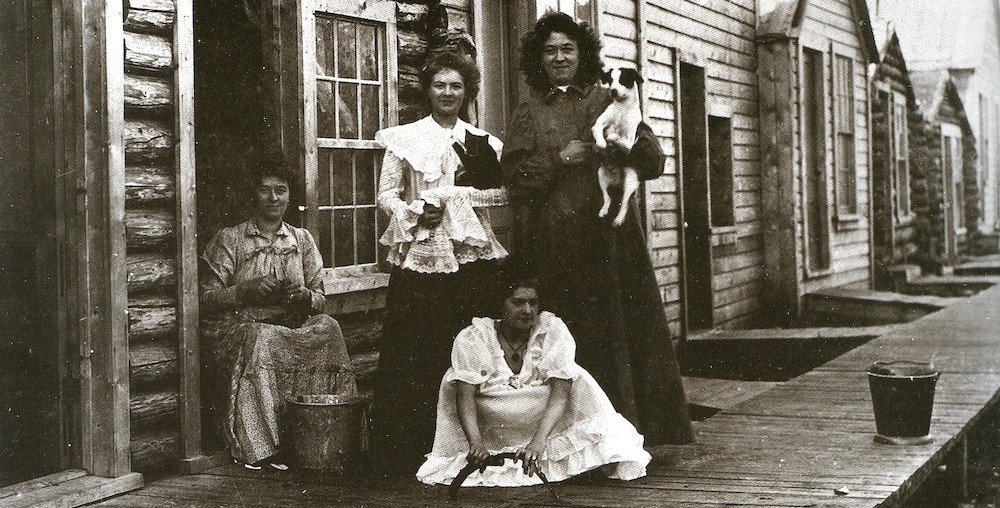
A Bed & Breakfast out of the history books.
Guest rooms, each named after a woman of the Klondike Gold Rush.
During the Klondike Gold Rush of 1898, rows of cribs (small two-room shacks) occupied the alley between our Inn and the Skagway Post Office. These accommodations were not for gold-seeking men but for the first women of the frontier. Seeking freedom and fortune, the women worked in the oldest profession—prostitution. These entrepreneurs understood that with a scarcity of women, they held power as gold-rushing men would pay dearly for a moment of companionship. Legend has it, the cribs in Paradise Alley, where the Skagway Inn now occupies, had an alphabetical nickname attached outside. Each nickname hid their true identity (so photos below are not accurate), and as a result, they left almost no traceable public records. The ”soiled doves” of Skagway eventually followed prospectors into the Yukon. The information comes from police reports of the alias used, or tall tales told under the midnight sun in Dawson. In frontier towns, prostitution was common practice, then regulated, and finally outlawed. Klondike women cashed in the pile of gold dust and nuggets to leave their nickname and the Klondike life behind. Ultimately, the cribs were abandoned or repurposed. A few cribs remain in Skagway, maintained by the Klondike Gold Rush NHP.
Using materials from an 1897—1898 bordello on Second Avenue moved to the current site, Max Gutfeld, built his residence in 1918. In the 1920s a rear wing was added by moving the vacant Ross-Higgins warehouse (built in 1901) from Fourth and Main. Finally, a log cabin structure was attached to the rear of the building.George Rapuzzi, one of the previous owners, researched the names of the crib/ladies to name each guest room. He was young enough to know stampeders that came to Skagway during the gold rush and was probably able to ask them questions. Each room's history as we understand it below:
Kitty Faith
Born in Iowa on January 25, 1866, to farmers. Her real name was either Amaretta or Henrietta. She came to Skagway at the peak of the Gold Rush in January 1898. She started as a Madam of a large, two-story “gentleman’s resort” on the south side of Seventh Avenue between Broadway and State for J. D. Stinebaugh a respectable barber. Kitty broke away from Stinebaugh in 1905 and opened her own parlor at the southwest corner of Broadway and Seventh. The Seventh Avenue Red Light District was shut down in September 1909 and Kitty was the last madam to leave the district. It is believed that she was the richest woman in Skagway, wealthier than Harriet Pullen. She purchased two lots on Alaska Street between Fourth and Fifth Avenue and opened up six brothels, running one of them herself and renting out the other five. In 1916, she married Chris Wandstead, a Swedish carpenter. They both moved to San Francisco, and Kitty put her brothels on the market.
Or was this first named after Klondike Kate?
Grace Maloney
Aka Grace Magill was not a prostitute in Skagway. She was a landowner of some Seventh Avenue restricted district properties, but she never lived in Skagway. She bought properties from madams as they left town, but there is no evidence that she ever practiced the trade. She lived in Dawson in 1901 and paid taxes on Skagway Seventh Avenue properties between 1905 and 1916. She married a Dawson miner named Magill.
Ida Freidinger
Born in Ohio in either 1844 or 1849. She first appeared in Skagway in September 1902 in a small business just north of Seventh Avenue. She likely had a small business, employing only one or two women. Among them was Essie Miller, who became a favorite. She died in March 1912, leaving all of her property to Essie Miller. Her funeral was well attended, and she was celebrated as a pioneer of Skagway.
Essie Miller
Born May 26, 1880, in Virginia, named Augusta. She first appeared in Skagway records in 1903, at the age of 23. Essie started in Skagway as a common prostitute. She probably worked the circuit from Seattle to Dawson, depending on where the business was best: Seattle in the winter, Skagway in the spring and fall, and Dawson in the summer. She worked for Madam Ida Freidinger and became one of her favorites. Essie was not able to become a “land-lady” or property-owning madam until the Red Light District was moved to Alaska Street in 1910. She bought the lot and built the largest brothel in the district. When Ida died in 1912, Essie inherited Ida’s three brothels. With Ida’s death, Essie’s prominence in the restricted district rivaled that of Kitty Faith. When Kitty left in 1916, Essie became the wealthiest and most prominent madam in Skagway. Tuck Flaharty, a long-time saloon keeper married Essie and they moved to Seattle, and opened a speak-easy.
Birdie Ash
One of the five women fined during the shutdown of the Alaska Street restricted district in November 1917. She received the lightest sentence, only $25 and costs compared to Essie Miller’s $200. That suggests she had a one-woman crib. She had paid her quarterly fines in 1904, and once each in 1907, 1908, and 1909, indicating that she was a part-time worker in Skagway.
Alice
There were two documented ladies named Alice.
Alice Brunette paid city-mandated fines in 1903, twice in 1904, and once in 1908. Alice Hall paid once in 1908 and twice in 1909.
Cleo Thrash paid the city-mandated fines once in 1906, three times in 1907, three times in 1908, and 1909.
Dot Atwood, the veteran of the group, paid the fine three times in 1903 (once to the U.S. Commissioner) and twice in 1904. As you can see, they were all in and out of town.
Florence Arbuckle paid fines twice in 1907, three times in 1908, and twice in 1909.
Hattie Mora paid fines three times in 1908.














